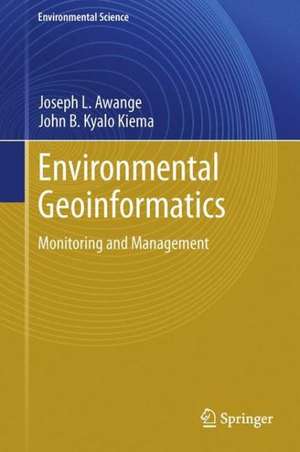Environmental Geoinformatics: Monitoring and Management: Environmental Science and Engineering
Autor Joseph L. Awange, John B. Kyalo Kiemaen Limba Engleză Hardback – 26 iun 2013
Thesehuman-inducedandnatural impactson the environment need to be well understood in order to developinformed policies,decisions, andremedial measuresto mitigate current and future negative impacts. To achieve this, continuous monitoring and management of the environment to acquire data that can be soundly and rigorously analyzed to provide information about its current state and changing patterns, and thereby allow predictions of possible future impacts, are essential. Developing pragmatic and sustainable solutions to address these and many other similar challenges requires the use ofgeodataand the application ofgeoinformatics.
This book presents the concepts and applications of geoinformatics, a multidisciplinary field that has at its core different technologies that support the acquisition, analysis and visualization of geodata for environmental monitoring and management. We depart from the 4D to the 5D data paradigm, which defines geodata accurately, consistently, rapidly and completely, in order to be useful without any restrictions inspace,timeorscaleto represent a truly global dimension of thedigital Earth. The book also features the state-of-the-art discussion of Web-GIS.
The concepts and applications of geoinformatics presented in this book will be of benefit to decision-makers across a wide range of fields, including those at environmental agencies, in the emergency services, public health and epidemiology, crime mapping, environmental management agencies, tourist industry, market analysis and e-commerce, or mineral exploration, among many others.
The title and subtitle of this textbook convey a distinct message. Monitoring -the passive part in the subtitle - refers to observation and data acquisition, whereas management - the active component - stands for operation and performance. The topic is our environment, which is intimately related to geoinformatics. The overall message is: all the mentioned elements do interact and must not be separated. Hans-Peter B ahr, Prof. Dr.-Ing. Dr.h.c., Karlsruhe Institute of Technology (KIT), Germany.
| Toate formatele și edițiile | Preț | Express |
|---|---|---|
| Paperback (1) | 1011.59 lei 43-57 zile | |
| Springer Berlin, Heidelberg – 27 aug 2016 | 1011.59 lei 43-57 zile | |
| Hardback (1) | 999.48 lei 38-44 zile | |
| Springer – 26 iun 2013 | 999.48 lei 38-44 zile |
Din seria Environmental Science and Engineering
- 18%
 Preț: 1238.42 lei
Preț: 1238.42 lei - 18%
 Preț: 2166.68 lei
Preț: 2166.68 lei - 18%
 Preț: 1420.88 lei
Preț: 1420.88 lei - 18%
 Preț: 914.20 lei
Preț: 914.20 lei - 18%
 Preț: 1225.94 lei
Preț: 1225.94 lei - 18%
 Preț: 1118.13 lei
Preț: 1118.13 lei - 18%
 Preț: 1402.74 lei
Preț: 1402.74 lei - 18%
 Preț: 3419.93 lei
Preț: 3419.93 lei - 18%
 Preț: 1223.55 lei
Preț: 1223.55 lei - 18%
 Preț: 1008.91 lei
Preț: 1008.91 lei - 18%
 Preț: 1234.46 lei
Preț: 1234.46 lei - 18%
 Preț: 1409.82 lei
Preț: 1409.82 lei - 18%
 Preț: 736.64 lei
Preț: 736.64 lei - 18%
 Preț: 949.73 lei
Preț: 949.73 lei - 18%
 Preț: 1287.47 lei
Preț: 1287.47 lei - 18%
 Preț: 2116.64 lei
Preț: 2116.64 lei - 18%
 Preț: 1231.95 lei
Preț: 1231.95 lei - 15%
 Preț: 641.71 lei
Preț: 641.71 lei - 23%
 Preț: 1129.31 lei
Preț: 1129.31 lei - 18%
 Preț: 1237.93 lei
Preț: 1237.93 lei - 18%
 Preț: 956.18 lei
Preț: 956.18 lei - 24%
 Preț: 1057.93 lei
Preț: 1057.93 lei - 24%
 Preț: 1079.06 lei
Preț: 1079.06 lei - 18%
 Preț: 953.03 lei
Preț: 953.03 lei - 18%
 Preț: 1233.06 lei
Preț: 1233.06 lei - 15%
 Preț: 666.73 lei
Preț: 666.73 lei - 18%
 Preț: 1222.31 lei
Preț: 1222.31 lei - 18%
 Preț: 1242.35 lei
Preț: 1242.35 lei - 18%
 Preț: 1232.89 lei
Preț: 1232.89 lei - 18%
 Preț: 1823.56 lei
Preț: 1823.56 lei - 18%
 Preț: 1228.96 lei
Preț: 1228.96 lei - 18%
 Preț: 1221.69 lei
Preț: 1221.69 lei - 18%
 Preț: 945.79 lei
Preț: 945.79 lei - 18%
 Preț: 1008.28 lei
Preț: 1008.28 lei - 24%
 Preț: 795.49 lei
Preț: 795.49 lei - 18%
 Preț: 1246.47 lei
Preț: 1246.47 lei - 18%
 Preț: 1239.85 lei
Preț: 1239.85 lei - 18%
 Preț: 957.62 lei
Preț: 957.62 lei - 18%
 Preț: 1244.89 lei
Preț: 1244.89 lei - 15%
 Preț: 640.55 lei
Preț: 640.55 lei - 18%
 Preț: 950.33 lei
Preț: 950.33 lei - 18%
 Preț: 1824.01 lei
Preț: 1824.01 lei - 15%
 Preț: 639.59 lei
Preț: 639.59 lei - 18%
 Preț: 947.50 lei
Preț: 947.50 lei - 18%
 Preț: 951.29 lei
Preț: 951.29 lei - 18%
 Preț: 1229.73 lei
Preț: 1229.73 lei
Preț: 999.48 lei
Preț vechi: 1315.11 lei
-24% Nou
Puncte Express: 1499
Preț estimativ în valută:
191.25€ • 200.19$ • 159.18£
191.25€ • 200.19$ • 159.18£
Carte tipărită la comandă
Livrare economică 26 martie-01 aprilie
Preluare comenzi: 021 569.72.76
Specificații
ISBN-13: 9783642340840
ISBN-10: 3642340849
Pagini: 564
Dimensiuni: 155 x 235 x 36 mm
Greutate: 0.91 kg
Ediția:2013
Editura: Springer
Colecția Springer
Seriile Environmental Science and Engineering, Environmental Science
Locul publicării:Berlin, Heidelberg, Germany
ISBN-10: 3642340849
Pagini: 564
Dimensiuni: 155 x 235 x 36 mm
Greutate: 0.91 kg
Ediția:2013
Editura: Springer
Colecția Springer
Seriile Environmental Science and Engineering, Environmental Science
Locul publicării:Berlin, Heidelberg, Germany
Public țintă
ResearchCuprins
Environmental
Monitoring
and
Management.-
Geodata
and
Geoinformatics.-
Fundamentals
of
surveying
and
geodesy.-
Modernization
of
GNSS.-
The
Global
Positioning
System.-
Environmental
Surveying
and
Surveillance.-
Fundamentals
of
Remote
Sensing.-
Optical
Remote
Sensing.-
Microwave
Remote
Sensing.-
Image
Interpretation
and
Analysis.-
Fundamentals
of
Photogrammetry.-
Digital
Photogrammetry.
Textul de pe ultima copertă
There
is
no
doubt
that
today,
perhaps
more
than
ever
before,
humanity
faces
a
myriad
of
complex
and
demanding
challenges.
These
include
natural
resource
depletion
and
environmental
degradation,
food
and
water
insecurity,
energy
shortages,
diminishing
biodiversity,
increasing
losses
from
natural
disasters,
and
climate
change
with
its
associated
potentially
devastating
consequences,
such
as
rising
sea
levels.
Thesehuman-inducedandnatural impactson the environment need to be well understood in order to developinformed policies,decisions, andremedial measuresto mitigate current and future negative impacts. To achieve this, continuous monitoring and management of the environment to acquire data that can be soundly and rigorously analyzed to provide information about its current state and changing patterns, and thereby allow predictions of possible future impacts, are essential. Developing pragmatic and sustainable solutions to address these and many other similar challenges requires the use ofgeodataand the application ofgeoinformatics.
This book presents the concepts and applications of geoinformatics, a multidisciplinary field that has at its core different technologies that support the acquisition, analysis and visualization of geodata for environmental monitoring and management. We depart from the 4D to the 5D data paradigm, which defines geodata accurately, consistently, rapidly and completely, in order to be useful without any restrictions inspace,timeorscaleto represent a truly global dimension of thedigital Earth. The book also features the state-of-the-art discussion of Web-GIS.
The concepts and applications of geoinformatics presented in this book will be of benefit to decision-makers across a wide range of fields, including those at environmental agencies, in the emergency services, public health and epidemiology, crime mapping, environmental management agencies, tourist industry, market analysis and e-commerce, or mineral exploration, among many others.
The title and subtitle of this textbook convey a distinct message. Monitoring -the passive part in the subtitle - refers to observation and data acquisition, whereas management - the active component - stands for operation and performance. The topic is our environment, which is intimately related to geoinformatics. The overall message is: all the mentioned elements do interact and must not be separated. Hans-Peter B ahr, Prof. Dr.-Ing. Dr.h.c., Karlsruhe Institute of Technology (KIT), Germany.
Thesehuman-inducedandnatural impactson the environment need to be well understood in order to developinformed policies,decisions, andremedial measuresto mitigate current and future negative impacts. To achieve this, continuous monitoring and management of the environment to acquire data that can be soundly and rigorously analyzed to provide information about its current state and changing patterns, and thereby allow predictions of possible future impacts, are essential. Developing pragmatic and sustainable solutions to address these and many other similar challenges requires the use ofgeodataand the application ofgeoinformatics.
This book presents the concepts and applications of geoinformatics, a multidisciplinary field that has at its core different technologies that support the acquisition, analysis and visualization of geodata for environmental monitoring and management. We depart from the 4D to the 5D data paradigm, which defines geodata accurately, consistently, rapidly and completely, in order to be useful without any restrictions inspace,timeorscaleto represent a truly global dimension of thedigital Earth. The book also features the state-of-the-art discussion of Web-GIS.
The concepts and applications of geoinformatics presented in this book will be of benefit to decision-makers across a wide range of fields, including those at environmental agencies, in the emergency services, public health and epidemiology, crime mapping, environmental management agencies, tourist industry, market analysis and e-commerce, or mineral exploration, among many others.
The title and subtitle of this textbook convey a distinct message. Monitoring -the passive part in the subtitle - refers to observation and data acquisition, whereas management - the active component - stands for operation and performance. The topic is our environment, which is intimately related to geoinformatics. The overall message is: all the mentioned elements do interact and must not be separated. Hans-Peter B ahr, Prof. Dr.-Ing. Dr.h.c., Karlsruhe Institute of Technology (KIT), Germany.
Caracteristici
The
book
brings
together
multi-disciplinary
techniques
for
tackling
environmental
problems
Numerous examples provided
Simplified presentation for non-experts in the field
Numerous examples provided
Simplified presentation for non-experts in the field
Descriere
Assembling
a
wealth
of
multi-disciplinary
techniques
for
addressing
environmental
problems
such
as
pollution
and
climate
change,
this
volume
features
simplified
presentation
aimed
at
non-experts,
demonstrating
geoinformatics
potency
as
a
research
toolkit.


























